-

2022年江苏省无锡市中考英语真题(解析版)
Jared ___15___ to stay at home, but his mom sent him anyway.He had to sit next to Jessica. At reading time, Mrs. Thomas asked Jared toread. Reading aloud always made Jared ___16___ . As he picked up the book, his hands shook.“He can’t read,” Jessica said. “I didn’t call on you, did I?”
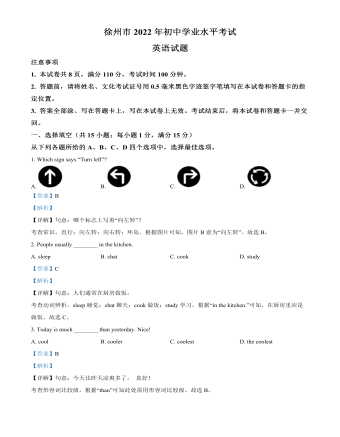
2022年江苏省徐州市中考英语真题(解析版)
Du, 23,is a student from Shanghai University. He won third place at the ninth IOIO (国际折纸奥林匹克) in February this year. A total of 803 competitors from 59countries and areas took part in this year’s event.
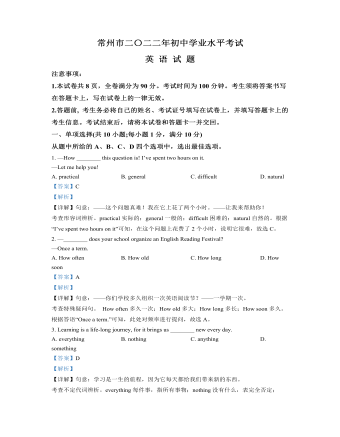
2022年江苏省常州市中考英语真题(解析版)
Russia’s skating silver medalist AlexandraTrusova, 17, amazed the world with five quadruple jumps (四周跳)during free skate at the Beijing Winter Olympics. No other woman has everfinished five quadruple jumps in an Olympic competition.
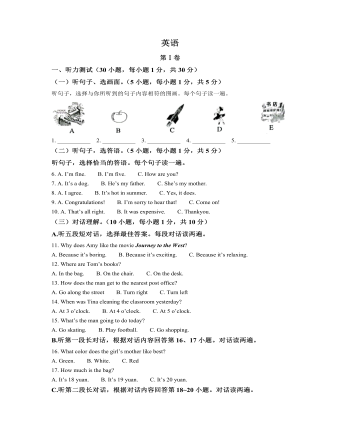
2022年广西贺州市中考英语真题(解析版)
Flying kites Kites have quite a long history. The earliest kites were made ofwood, instead of paper. Nowadays, the three most famous kites are the Beijingkite, Tianjin kite, and Weifang kite. And they are quite different from eachother. For example, the swallow-shaped kite is a well-known Beijing style.

2022年江苏省宿迁市中考英语真题 (解析版)
ThreeRiver-Source National Park on the Qinghai-TibetPlateau(青藏高原),is the largest national park in China. Because it is home to the sources of theYangtze, Yellow and Lancang rivers, people call it “China’s water tower”.
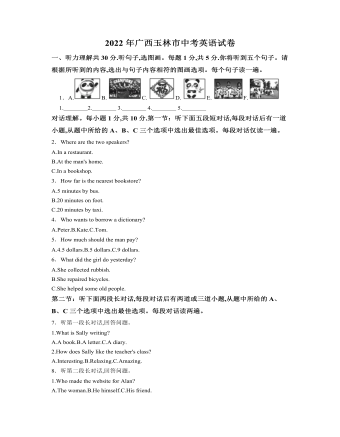
2022年广西玉林市中考英语真题(解析版)
Antarctica is a continent (大陆) of ice. There is hardlyany rain in Antarctica, so the Antarctic Desert becomes the driest desert inthe world. It is also the world’s largest desert by area.
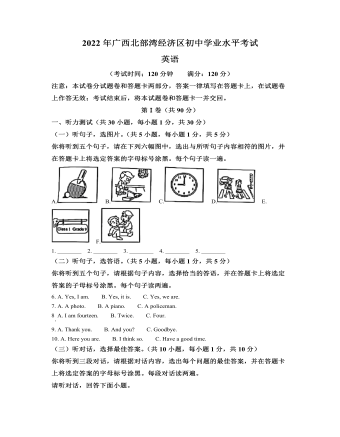
2022年广西北部湾经济区中考英语真题(解析版)
Ibelieved that I was right and he was wrong, and Tony believed that I was wrongand he was right. Our teacher, a kind and smart lady, decided to teach us alesson. She brought us to the front of the class and placed him on one side ofher desk and me on the other. In the middle of her desk was a large and roundobject. I could clearly see that it was black. The teacher asked us what colorthe object was. “White,” Tony answered. I couldn’t believe he said the objectwas white! “Clearly, it was black!” Another argument started between Tony andme, this time about the color of the object.
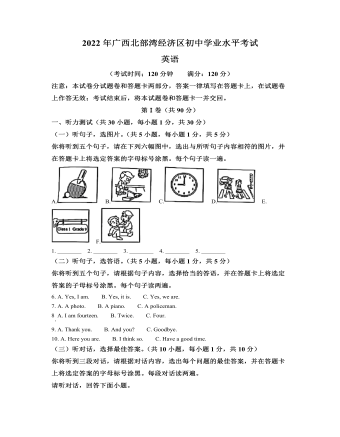
2022年广西北部湾经济区中考英语真题(解析版)
Ibelieved that I was right and he was wrong, and Tony believed that I was wrongand he was right. Our teacher, a kind and smart lady, decided to teach us alesson. She brought us to the front of the class and placed him on one side ofher desk and me on the other. In the middle of her desk was a large and roundobject. I could clearly see that it was black. The teacher asked us what colorthe object was. “White,” Tony answered. I couldn’t believe he said the objectwas white! “Clearly, it was black!” Another argument started between Tony andme, this time about the color of the object.
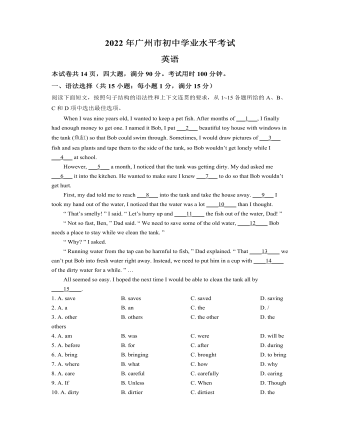
2022年广东省广州市中考英语真题(解析版)
When youand your friends turn to each other to talk about problems or troubles, yougive each other advice and help. One important thing of our growth is to makedecisions to help our friends and learn to support each other. This requires usto learn what it means to help friends and how to help them in right ways.
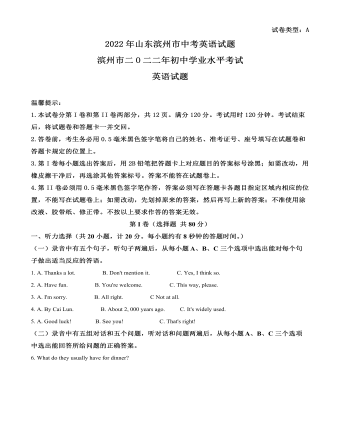
2022年山东省滨州市中考英语真题(解析版)
Everyone knows how similar chimpanzees (黑猩猩)are to humans. So it’s no surprise that their greetings are also close to ours.The most common ways of greeting between chimpanzees are hand touching andhugging. Sometimes they also kiss each other. Some chimpanzees can even learnsimple sign language.
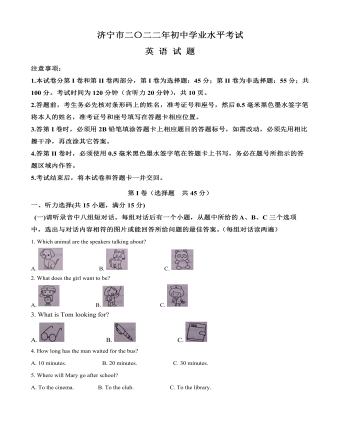
2022年山东省济宁市中考英语真题(解析版)
Raden Roro Hendarti, nearly 50 years old, is alibrarian in Muntang village. She started a “trash library”, hoping to makechildren read more as well as make them realize the importance of environmentprotection. Each weekday, Raden puts all kinds of books on the back of herthree-wheeler (三轮车)and rides to Muntang village. There, children line up to exchange plastic cups,bags and other trash for books from Raden’s mobile library. After finishing theexchange, Raden carries back all the trash.
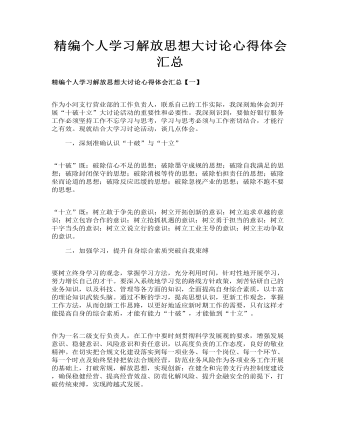
精编个人学习解放思想大讨论心得体会汇总
一,深刻准确认识“十破”与“十立” “十破”既:破除信心不足的思想;破除墨守成规的思想;破除自我满足的思想;破除封闭保守的思想;破除消极等待的思想;破除怕担责任的思想;破除坐而论道的思想;破除反应迟缓的思想;破除忽视产业的思想;破除不跑不要的思想。 “十立”既:树立敢于争先的意识;树立开拓创新的意识;树立追求卓越的意识;树立包容合作的意识;树立抢抓机遇的意识;树立勇于担当的意识;树立干字当头的意识;树立立说立行的意识;树立工业主导的意识;树立主动争取的意识。
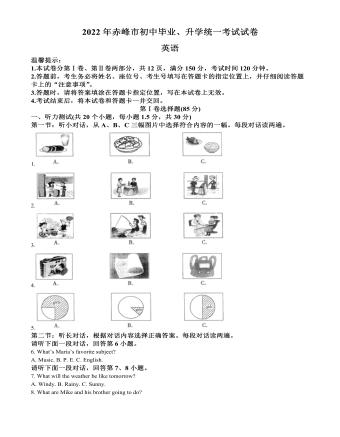
2022年内蒙古赤峰市中考英语真题(解析版)
Chopsticksoriginated from(起源于) China.Though simple and little, they are agreat invention in the history of humans. There are many legends aboutChopsticks, Da Yu and Chopsticks is one of them.It issaid that during Yao and Shun times, Shun ordered Yu to control the flood. Oneday, Yu took a boat to an island, he was so hungry that he used an earth pot tocook meat. After the meat was well-done in boiled water, he didn’t want towaste time to wait for it to cool, so he took two branches to pick up the meatfrom the soup. After, to save time, he always took small branches to take outfood from the hot pot. For a long time, he was skilled at picking up food withsmall sticks. In this way, the first types of chopsticks were born.
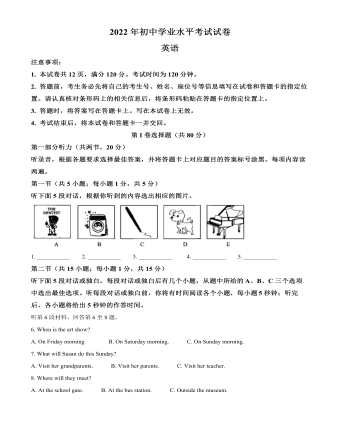
2022年内蒙古包头市中考英语真题(解析版)
Mostschools offer different kinds of subjects and activities for students, but someschools offer additional training in certain areas, such as the performing andarts. In this way, schools can help students develop their artistic talentsfrom an early age and have greater success in their future profession. THE ROYAL BALLET(芭蕾舞)SCHOOL
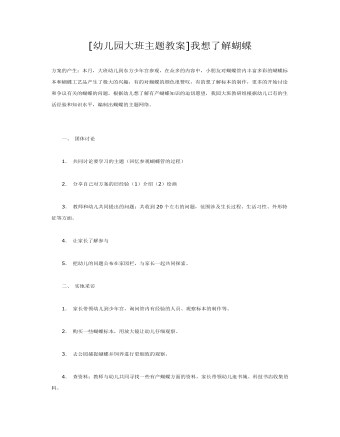
[幼儿园大班主题教案]我想了解蝴蝶
一、团体讨论1.共同讨论要学习的主题(回忆参观蝴蝶管的过程)2.分享自己对方案的旧经验(1)介绍(2)绘画3.教师和幼儿共同提出的问题:共收到20个左右的问题,范围涉及生长过程、生活习性、外形特征等方面。4.让家长了解参与5.把幼儿的问题公布在家园栏,与家长一起共同探索。
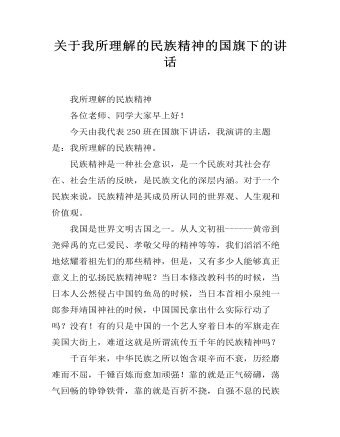
关于我所理解的民族精神的国旗下的讲话
我所理解的民族精神各位老师、同学大家早上好!今天由我代表250班在国旗下讲话,我演讲的主题是:我所理解的民族精神。民族精神是一种社会意识,是一个民族对其社会存在、社会生活的反映,是民族文化的深层内涵。对于一个民族来说,民族精神是其成员所认同的世界观、人生观和价值观。我国是世界文明古国之一。从人文初祖------黄帝到尧舜禹的克已爱民、孝敬父母的精神等等,我们滔滔不绝地炫耀着祖先们的那些精神,但是,又有多少人能够真正意义上的弘扬民族精神呢?当日本修改教科书的时候,当日本人公然侵占中国钓鱼岛的时候,当日本首相小泉纯一郎参拜靖国神社的时候,中国国民拿出什么实际行动了吗?没有!有的只是中国的一个艺人穿着日本的军旗走在美国大街上,难道这就是所谓流传五千年的民族精神吗?
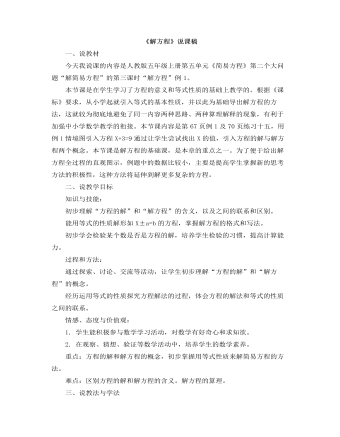
小学数学人教版五年级上册《解方程》说课稿
二、说教学目标知识与技能:初步理解“方程的解”和“解方程”的含义,以及之间的联系和区别。能用等式的性质解形如X±a=b的方程,掌握解方程的格式和写法。初步学会检验某个数是否是方程的解,培养学生检验的习惯,提高计算能力。过程和方法:通过探索、讨论、交流等活动,让学生初步理解“方程的解”和“解方程”的概念。经历运用等式的性质探究方程解法的过程,体会方程的解法和等式的性质之间的联系。情感、态度与价值观:1. 学生能积极参与数学学习活动,对数学有好奇心和求知欲。2. 在观察、猜想、验证等数学活动中,培养学生的数学素养。重点:方程的解和解方程的概念,初步掌握用等式性质来解简易方程的方法。难点:区别方程的解和解方程的含义。解方程的算理。三、说教法与学法教法:新课标指出,教师是学习的组织者、引导者、合作者,充分发挥学生的主体性。根据这一理念,我在教学中通过观察、猜想、验证等方式,自主探索、自主学习。有目的地运用知识迁移的规律,引导学生进行观察、比较、分析、概括,培养学生的逻辑思维能力。学法:①让学生学会以旧引新,掌握并运用知识迁移进行学习的方法;②让学生学会自主发现问题,分析问题,解决问题的方法。
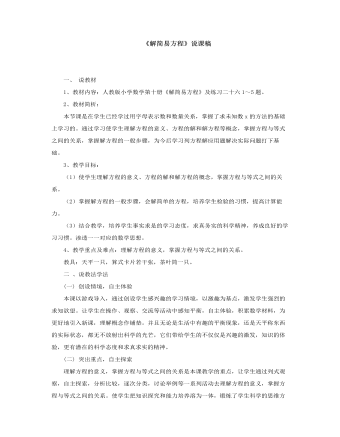
小学数学人教版五年级上册解简易方程说课稿
一、 说教材1、教材内容:人教版小学数学第十册《解简易方程》及练习二十六1~5题。2、教材简析:本节课是在学生已经学过用字母表示数和数量关系,掌握了求未知数x的方法的基础上学习的。通过学习使学生理解方程的意义、方程的解和解方程等概念,掌握方程与等式之间的关系,掌握解方程的一般步骤,为今后学习列方程解应用题解决实际问题打下基础。3、教学目标:(1)使学生理解方程的意义、方程的解和解方程的概念,掌握方程与等式之间的关系。(2)掌握解方程的一般步骤,会解简单的方程,培养学生检验的习惯,提高计算能力。(3)结合教学,培养学生事实求是的学习态度,求真务实的科学精神,养成良好的学习习惯。渗透一一对应的数学思想。
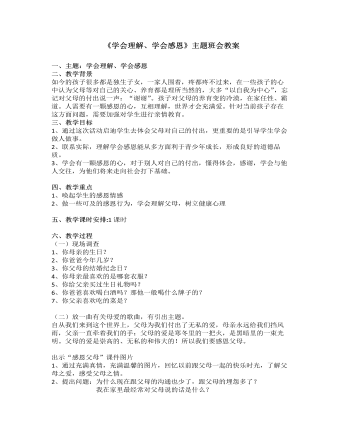
《学会理解、学会感恩》主题班会教案
二、教学背景如今的孩子很多都是独生子女,一家人围着,疼都疼不过来,在一些孩子的心中认为父母等对自己的关心、养育都是理所当然的,大多“以自我为中心”,忘记对父母的付出说一声:“谢谢”。孩子对父母的养育变的冷漠,在家任性、霸道。人需要有一颗感恩的心,互相理解,世界才会充满爱。针对当前孩子存在这方面问题,需要加强对学生进行亲情教育。三、教学目标1、通过这次活动启迪学生去体会父母对自己的付出,更重要的是引导学生学会做人做事。2、联系实际,理解学会感恩能从多方面利于青少年成长,形成良好的道德品质。3、学会有一颗感恩的心,对于别人对自己的付出,懂得体会,感谢,学会与他人交往,为他们将来走向社会打下基础。四、教学重点1、唤起学生的感恩情感2、做一些可及的感恩行为,学会理解父母,树立健康心理
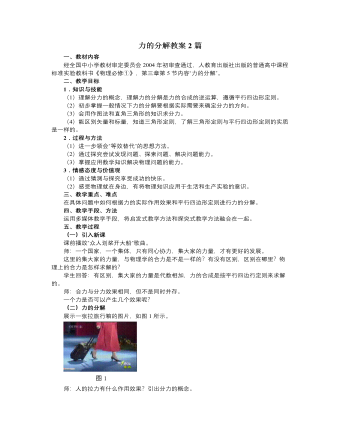
人教版新课标高中物理必修1力的分解教案2篇
一、教材内容经全国中小学教材审定委员会2004年初审查通过,人教育出版社出版的普通高中课程标准实验教科书《物理必修①》,第三章第5节内容“力的分解”。二、教学目标1.知识与技能(1)理解分力的概念,理解力的分解是力的合成的逆运算,遵循平行四边形定则。(2)初步掌握一般情况下力的分解要根据实际需要来确定分力的方向。(3)会用作图法和直角三角形的知识求分力。(4)能区别矢量和标量,知道三角形定则,了解三角形定则与平行四边形定则的实质是一样的。2.过程与方法(1)进一步领会“等效替代”的思想方法。(2)通过探究尝试发现问题、探索问题、解决问题能力。(3)掌握应用数学知识解决物理问题的能力。3.情感态度与价值观(1)通过猜测与探究享受成功的快乐。(2)感受物理就在身边,有将物理知识应用于生活和生产实验的意识。三、教学重点、难点在具体问题中如何根据力的实际作用效果和平行四边形定则进行力的分解。